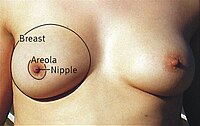
Photo from wikipedia
PURPOSE With the advent of three-dimensional (3D) breast imaging modalities such as digital breast tomosynthesis (DBT) and dedicated breast CT (bCT), research into new anthropomorphic breast phantoms has accelerated. These breast… Click to show full abstract
PURPOSE With the advent of three-dimensional (3D) breast imaging modalities such as digital breast tomosynthesis (DBT) and dedicated breast CT (bCT), research into new anthropomorphic breast phantoms has accelerated. These breast phantoms are important for the optimization of new breast imaging systems, assessing new regulatory submissions to prove safety and effectiveness, and for developing new approaches to acceptance and constancy testing of 3D breast imaging systems. This paper provides a review of current research investigating both digital and physical breast phantom development for use in x-ray based imaging. METHODS Two approaches for designing anthropomorphic, digital breast phantoms are discussed, procedural model-based phantom generation, where breast features are expressed using mathematical models, and patient-based generation, where breast structures from tissue specimens or patient-based breast MR or CT volumes are segmented. Following this discussion, a review of physical anthropomorphic phantoms is given, with emphasis on the advantages and disadvantages present with each approach. CONCLUSIONS This paper provides a summary of the state-of-the-art in anthropomorphic breast phantom development for x-ray breast imaging. The primary advantage of model-based digital phantoms is that an unlimited number of phantoms with varying size, shape, and density can be generated. Current research on model-based breast phantoms is producing more and more realistic breast models; however, they probably are not yet able to pass the so-called "fool the radiologist" visualization test. Empirical patient-based breast phantoms are typically based on clinical breast CT data and look more realistic. However, clinical breast CT images have limited spatial resolution and thus do not always portray the finer details in the breast. A number of innovative solutions have been proposed for fabricating physical anthropomorphic breast phantoms based on digital phantom models; however, a number of challenges remain, including realistic modeling of x-ray attenuation properties and accurately representing high-frequency structures within breast.
Journal Title: Medical physics
Year Published: 2018
Link to full text (if available)
Share on Social Media: Sign Up to like & get
recommendations!